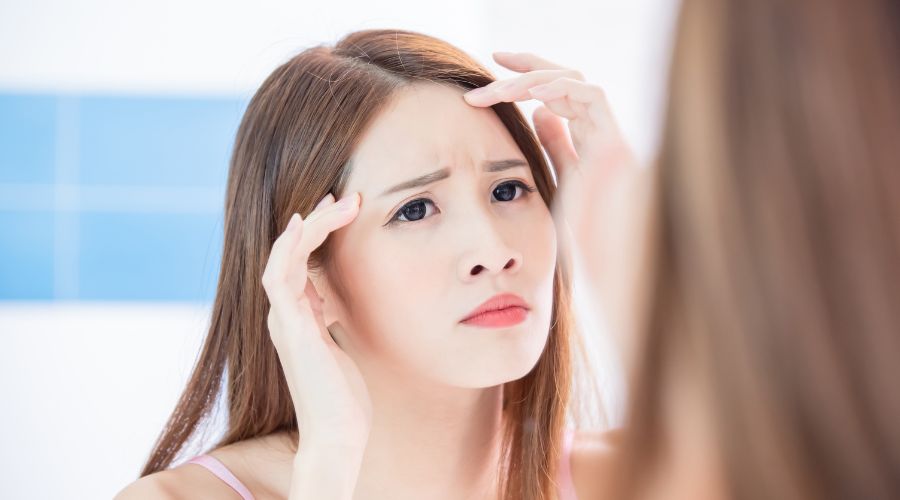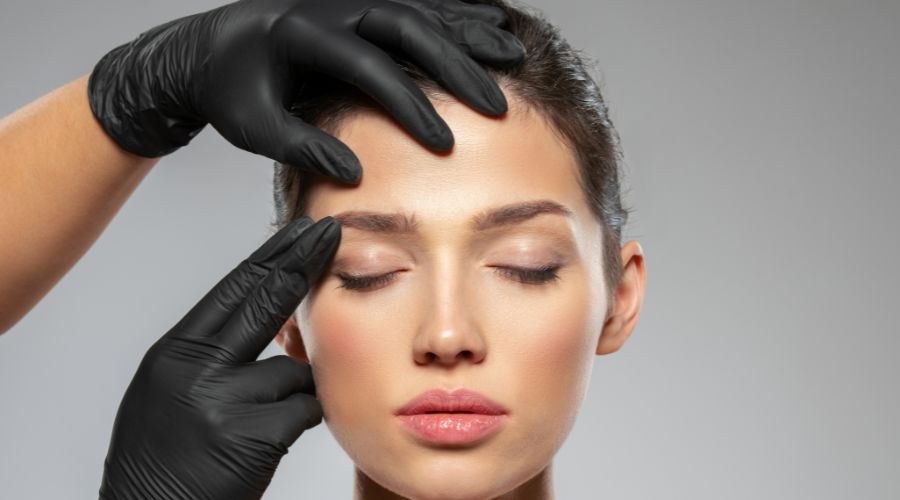Forehead wrinkles are a natural part of the aging process, and they can also be caused by repeated facial expressions like frowning, squinting, and raising the eyebrows. While forehead wrinkles are not usually a medical concern, they can be a cosmetic concern for some people.
If you are also facing forehead wrinkles problems then you can check out this blog. We have covered most of the aspects that will help you to overcome the problem of forehead wrinkles.
1. Why Do Forehead Wrinkles Appear?

Forehead wrinkles can appear for a variety of reasons. The most common cause is aging. As we age, our skin loses its elasticity and becomes less able to retain moisture, which can lead to wrinkles and fine lines. Other factors that can contribute to forehead wrinkles include:
- Repetitive Facial Expressions: Repeatedly making certain facial expressions, such as raising your eyebrows or furrowing your brow, can cause wrinkles to form over time. These movements cause the muscles in your forehead to contract, and with time, the repetitive movement causes the skin to lose elasticity and form wrinkles.
- Aging: Forehead wrinkles can appear as a natural part of the aging process. As we age, our skin loses elasticity and becomes less able to bounce back from facial expressions, leading to the development of wrinkles and fine lines.
- Sun Damage: Exposure to the sun’s harmful UV rays can accelerate the aging process and contribute to premature wrinkling, including forehead wrinkles. Ultraviolet (UV) rays from the sun can break down collagen and elastin fibres in the skin, which can lead to a loss of skin elasticity and the formation of wrinkles. In addition, repeated sun exposure can cause sunspots, discoloration, and other skin damage that can make wrinkles more noticeable.
- Genetics: Yes, genetics can play a role in the development of forehead wrinkles. The genes we inherit from our parents can affect the way our skin ages, including how prone we are to wrinkles and how quickly they appear. For example, some people may have naturally thinner or drier skin, which can make them more susceptible to wrinkles. Other individuals may produce less collagen and elastin, which are important proteins that keep the skin firm and elastic. These factors can be influenced by our genes.
- Lifestyle Factors: Forehead wrinkles can be developed due to unhealthy lifestyle habits that include smoking as it reduces blood flow to the skin and damages collagen and elastin fibers and dehydration, so drinking plenty of water and using moisturizers can help to keep the skin hydrated. A diet high in sugar and processed foods can cause inflammation in the body, which can accelerate the aging process and contribute to the development of wrinkles. Even the lack of sleep can lead to dark circles and puffiness around the eyes, which can make wrinkles more noticeable.
Overall, a combination of genetics, environmental factors, and lifestyle habits can contribute to the appearance of forehead wrinkles. While it’s impossible to completely prevent them from forming, taking care of your skin and adopting healthy habits can help minimise their appearance and slow down their formation.
2. Ways To Prevent Forehead Wrinkles

While it is impossible to completely prevent forehead wrinkles, there are several steps you can take to reduce their appearance and slow down their formation that is mentioned below:
- Protect Your Skin From The Sun: The sun’s ultraviolet (UV) rays can cause damage to the skin, which can lead to premature aging and can accelerate the formation of wrinkles. It’s important to start protecting your skin from the sun at an early age, as sun damage can accumulate over time and lead to more noticeable wrinkles later in life. To prevent this, use a broad-spectrum sunscreen with at least SPF 30 daily and avoid prolonged exposure to the sun. Apply sunscreen on your skin every two to three hours if you’re spending a long time outdoors. Also, cover your skin with clothing, and hats and wear the shades during the sun’s peak hours.
- Avoid Repetitive Facial Expressions: Repetitive facial movements, such as frowning or raising your eyebrows, can contribute to the formation of wrinkles. Try to be mindful of these movements and relax your facial muscles as much as possible.
- Stay Hydrated: Staying hydrated is an important step that can help keep your skin hydrated and reduce the appearance of wrinkles. Dehydration can cause the skin to become dry and lose its elasticity, which can lead to the formation of wrinkles. Aim to drink at least 8-10 glasses of water per day to keep your skin and body hydrated.
- Use Anti-Aging Skincare Products: Look for products that contain retinoids, which can stimulate collagen production and reduce the appearance of wrinkles. You can also use products with antioxidants like vitamin C to help protect your skin from free radicals that can cause damage.
- Get Enough Sleep: Getting enough sleep is an important step in preventing forehead wrinkles. When we sleep, our body repairs and regenerates the skin, including the production of collagen and elastin which are important for skin elasticity and firmness. Lack of sleep can lead to a decrease in collagen production, resulting in the formation of wrinkles. Aim for 7-8 hours of quality sleep each night to allow your skin to repair and regenerate.
- Manage Stress: Stress produces an impressive array of physical changes, from elevated heart rate and blood pressure to increased cortisol secretion in the body. These changes can take a toll on your skin, leading to wrinkles and other signs of aging. To slow down the aging process and keep lines away, practice regular stress-reduction techniques such as yoga, meditation and deep breathing.
- Eat a Healthy Diet: Eating a healthy diet can also help prevent forehead wrinkles. The foods you eat can affect the health and appearance of your skin, and a well-balanced diet can provide your skin with the nutrients it needs to stay healthy and youthful-looking. By eating a healthy diet, you can provide your body with the nutrients it needs to keep your skin healthy and prevent the formation of forehead wrinkles. A diet rich in fruits, vegetables, and healthy fats can help support healthy skin and reduce the appearance of wrinkles.
- Consider Cosmetic Procedures: In some cases, cosmetic procedures such as Botox injections or dermal fillers may be recommended to reduce the appearance of forehead wrinkles. You can discuss the cosmetic procedure options with a qualified professional.
By incorporating these habits into your daily routine, you can help prevent or minimise the formation of forehead wrinkles and maintain a youthful, vibrant appearance.
3. How to Get Rid of Forehead Wrinkles?

Do you want to reduce the appearance of forehead wrinkles? There are a few methods you can use that are both effective and affordable. These include using moisturizers with proven anti-aging ingredients, such as retinol and vitamin C, as well as sunscreens to prevent further damage from UV exposure. You can also consider dermatological treatments like laser resurfacing and chemical peels, or even injectables like Botox and dermal fillers.
- Topical Treatments: There are several anti-aging skincare products that can help in reducing the appearance of wrinkles. Look for products containing retinoids, which can stimulate collagen production and improve skin texture. Other ingredients such as hyaluronic acid, vitamin C, and peptides can also help improve skin elasticity and reduce the appearance of fine lines and wrinkles.
- Botox: Botox is a cosmetic treatment that involves injecting a small amount of botulinum toxin into the muscles in your forehead. This treatment can temporarily relax the muscles and smooth out the wrinkles. Results typically last for several months.
- Dermal Fillers: Dermal fillers are another cosmetic treatment that can be used to fill in wrinkles and restore volume to the face. Fillers are typically made from hyaluronic acid and can last from six months to a year.
- Microdermabrasion: Microdermabrasion is a non-invasive skin resurfacing treatment that uses a special tool to exfoliate the top layer of the skin. This treatment can help reduce the appearance of fine lines and wrinkles and improve skin texture and tone.
- Chemical Peels: Applying a chemical solution to the skin in order to eliminate the outermost layer of dead skin cells is known as a chemical peel. This procedure can lessen the visibility of wrinkles while enhancing skin tone and texture.
It’s important to consult with a qualified professional to determine the best treatment option for your skin type and specific concerns. Additionally, practicing good skincare habits, staying hydrated, and protecting your skin from the sun can help prevent the formation of new wrinkles and maintain healthy, youthful-looking skin.
Conclusion
Forehead wrinkles are a natural part of the aging process, but there are steps you can take to minimise their appearance and prevent further damage. Whether you choose to use anti-aging skincare products, consider cosmetic treatments, or adopt healthy lifestyle habits, the key is to take care of your skin and prioritise its health. By doing so, you can help slow down the formatio

